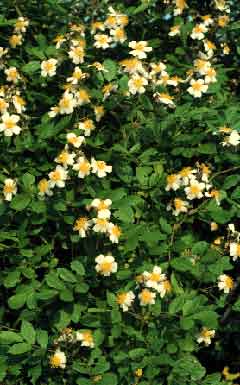(Rosa multiflora)
Description: Multiflora rose is a perennial shrub, reproducing by seeds and sometimes rooting at the tips of drooping side canes. The stems are up to 10 feet long, in clumps and are arching or trailing, usually growing about 6 feet erect with the tips drooping almost to the ground. The stems are covered with many stiff thorns. The leaves are pinnately compound, usually with 7 or 9 leaflets. The leaflets are ¾ to 1 ½ inches long, elliptic, nearly smooth on the upper surface and paler with short hairs on the underside. The flowers are mostly white, sometimes pinkish, about ¾ to 1 ½ inches broad, and borne in a many-flowered panicle. The fruit (hips) are bright red, nearly round, and about ¼ inch in diameter.
Distribution: Multiflora rose has been widely planted in Iowa as a fencerow beautifier and wildlife habitat. It is found throughout Johnson County. It has spread into permanent pastures and other untilled areas, primarily in Eastern and Southern Iowa.
What’s the problem?: Multiflora rose can take over open forests or pasture land, seriously reducing livestock grazing potential. Problems with multiflora rose as a weed are usually greatest in rough, wooded pastures. This plant’s large, thick clumps and sharp thorns can also impair recreational uses. Multiflora rose does not always overwinter well in northern Iowa. The plant is also used as a rootstock for other cultivated roses. Care should be taken to correctly identify this species, as Iowa has several similar native roses, which are harmless and beneficial to our environment. Multiflora rose is not considered noxious if it is cultivated for or used as understock for cultivated roses, or as ornamental shrubs in gardens.
Management methods: Multiflora rose can be controlled through proper pasture management. Avoid overgrazing of grass, as a well-maintained pasture will compete with most weed species. Annual mowing, along with removal of plants by hand or small equipment will also provide control. Herbicides can be another tool to reduce multiflora rose populations if used properly and safely. Dormant treatments, or foliar treatments when actively growing can result in good control. Always read and follow herbicide labels. Prescribed burning can also assist in management of this weed as dead canes will burn up, and the thin "bark" can be scorched enough to kill the plant.

Photo courtesy of K.R. Robertson, Illinois Natural History Survey
